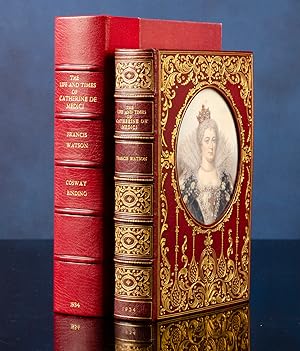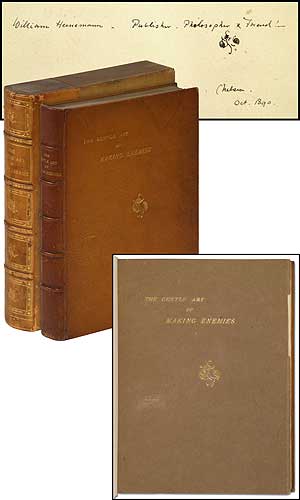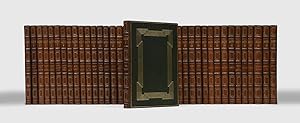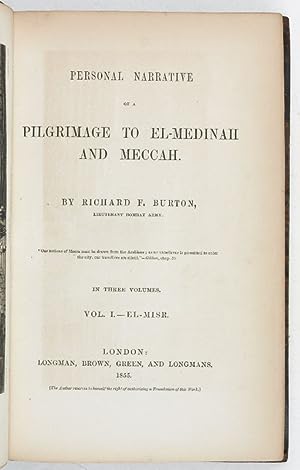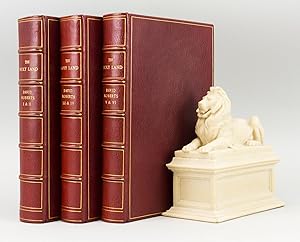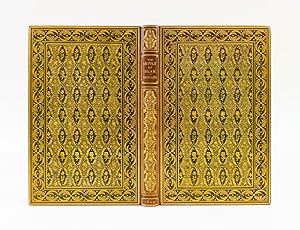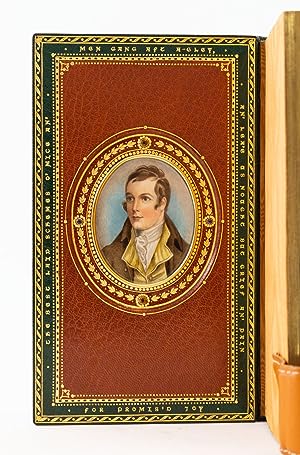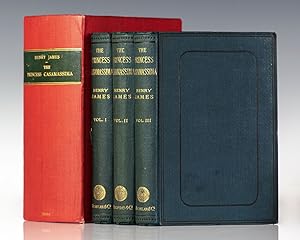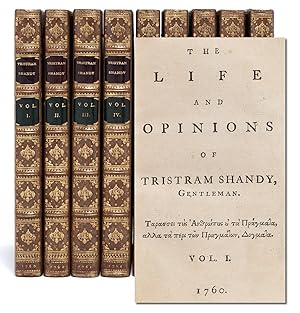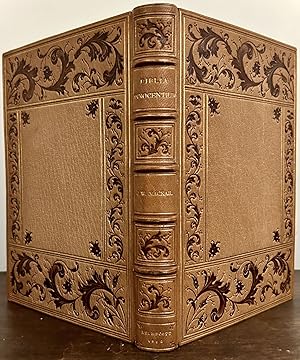zaehnsdorf (Más de 2.100 resultados)
Tipo de artículo
- Todo tipo de artículos
- Libros (2.182)
- Revistas y publicaciones (1)
- Cómics
- Partituras
- Arte, grabados y pósters (5)
- Fotografías (2)
- Mapas
-
Manuscritos y
coleccionismo de papel (4)
Condición
Encuadernación
Más atributos
- Primera edición (611)
- Firmado (206)
- Sobrecubierta (24)
- Con imágenes del vendedor (1.678)
- Sin impresión bajo demanda (1.601)
Gastos de envío gratis
Ubicación del vendedor
Valoración de los vendedores
-
Monograph of the Felididae or Family of Cats
Publicado por M. & N. Hanhart, New York, 1878
Librería: Heritage Book Shop, ABAA, Beverly Hills, CA, Estados Unidos de America
SMIT, J. Ilustrador. New York]: printed by Taylor & Francis, published by the author for the subscribers, [1878-] 1883. Large folio. (23 1/2 x 19 inches; 600 x 475 mm). xvi, [2, plate list]. With all forty-three fine hand-coloured lithographic plates drawn on stone by Joseph Smit from drawings by Joseph Wolf, printed M. & N. Hanhart. Each plate accompanied by at least one leaf of explanatory letterpress text. The original blue printed upper wrappers of parts 1-11 bound in at the back. Beautifully bound by Zaehnsdorf in half green morocco over green cloth. Spine lettered in gilt. Top edge gilt, others uncut. MArbled endpapers. Some minor rubbing to board edges. A few instances of foxing to preliminary pages, but plates are extremely clean. Fore-edge with some foxing. Previous owner's bookplate on front pastedown. An excellent copy of the finest work on the cat family with magnificent hand-coloured plates after Joseph Wolf. Originally issued in eleven parts, the monograph describes and figures all the species of cat then known. As Elliot writes in the preface "Among the Families which constitute the Class Mammalia no more attractive one can be found than that of Felidae, as its members possess in the highest degree a beauty, both of form and colouring, most gratifying to the eye, and are also endowed with physical strength and weapons of offence not surpassed by any known creature now living upon the earth. The Family comprises not only the largest and most ferocious of the beasts of prey, but also the graceful little animal that delights to make its home within mans' abode". The work was prompted by the need to resolve the confusion that had built up around the naming of the various species of Felidae, particularly amongst the smaller cats. The examples shown here were collected by Elliot after visiting all the great museums and zoological societies on both sides of the Atlantic. This allowed him to make a comparative study of skeletons and skins and reduce the number of separate species by nearly a third. The resulting work was considered the definitive monograph on the cat family and is still the most beautiful work on the subject forming a fitting companion to Elliot's sumptuous ornithological folios. BM (NH) II, p.522; Nissen ZBI 1279 (incorrect date); Wood p.332. HBS 68737. $110,000.
-
El Ingenioso Hidalgo Don Quixote de la Mancha.
Publicado por Roger Velpius, 1607
Librería: Blackwell's Rare Books ABA ILAB BA, Oxford, Reino Unido
woodcut initials and ornaments, paper-flaw at lower outer corner of L2 (no loss to text), a bit of ink staining on R4r, occasional light browning, a few mild damp-stains in the margins, ?wax stain on front fly-leaf affecting the title-page slightly, pp. [xxiv], 592, [8], 8vo, contemporary calf, double gilt fillets on sides, arms (unidentified: Franco-Belgian?) blocked in gilt to both covers, that on the upper cover with a little loss of gilt, that on the lower good and bright, flat spine with a border of double gilt fillets, headcaps defective, cracking to joints, rear endpapers sometime renewed (not, apparently, very recently) preserved in a fine red morocco backed folding box by Trevor Lloyd. Rare, especially in commerce. A complete copy in a fine contemporary binding of the first Brussels (first extra-Iberian) edition of the novel "which is to Spanish literature what Shakespeare is to English" (Bloom). Ruiz notes that this edition was the most finely printed of the early versions to date. Don Quixote won immediate fame when first printed in 1605 for its "variety, liveliness, and gibes at the famous. "Its subdued pathos and universal humanity have assured it a place as "one of those universal works which are read by all ages at all times" (PMM). It quickly went through numerous editions,and translations. This edition is the seventh overall - all early editions are rare. Velpius's edition, which introduced the text to Northern Europe, is based on Cuesta's second of 1605, with many misprints and other textual infelicities corrected, and itself 'corregido con cuidado' (Palau). RBH and ABPC record only 3 other copies at auction in the last 30 years. In Maggs's 1927 catalogue a copy in a Zaehnsdorf binding (with the second part) was priced £52 10s. The second part, which Cervantes wrote in response to spurious sequels, appeared 10 years later. The arms feature as 'unidentified' at the end of vol. 15 of 'Manuel de l'Amateur de Reliures Armoriées Françaises' (with thanks to Dr Sara Trevisan pointing us there). (CCPB000042471-4; Palau 51981; Ruiz 7; USTC 5039050; cf. PMM 111).
-
Libro utillissimo et molto necessario di varii secreti importantissimi per l'essercitio di guerra, come appare nela seguente indice.
Publicado por Italy, before 1581., 1581
Librería: Antiquariat INLIBRIS Gilhofer Nfg. GmbH, Vienna, A, Austria
Manuscrito
Small folio (210 x 277 mm). Title, (14) ff. of contents, 187 numbered ff. (a total of 202 ff.) with 60 coloured illustrations (mainly full-page, 7 on large folding sheets). Italian manuscript on paper (watermark: a bird on 3 hillocks, Briquet 12,250 [ca. 1566-1583]). 16th century red morocco (possibly German) with gilt-stamped border fillets, cornerpieces and centrepiece (dated "1581" on upper cover), lacking ties. All edges gilt. Stored in modern slipcase. An unusual and attractive Italian Renaissance manuscript on the art of war, lavishly illustrated in colour and in a sumptuous contemporary binding. The text comprises eight chapters dealing with the duties of the captain, making gunpowder, siege-breaking devices, the deployment through artillery of artificial fire, smoke and poisonous fumes, the use of cannons, ballistics and artillerymen, and the logistics and practice of moving artillery and cavalry. - The title of the first chapter accords with that in an earlier manuscript in the Biblioteca Riccardiana in Florence (Ms 2525), "Il primo capo tratta universalmente dell'uffitio del capitano dell' Arteglieria, con che ordine, modo et diligenza egli habbia à procedure, ad ogni cosa appartinenti alla munitione dell' Artegl[eri]a et all' ufficio suo", dated ca. 1529-30 (cf. Mariano D'Ayala, Bibliografia militare-italiana [1854], p. 159). The third chapter contains illustrations of siege devices similar to those in Franz Helm's "Armamentarium Principale oder Kriegsmunition und Artillerey-Buch" (1625), which was originally written around 1530. - Some paper (and text) loss through oxidation of the ink, restored and silked. Rebacked, retaining part of the old spine, by Joseph William Zaehnsdorf in 1919, according to old pencil note on flyleaf. - Provenance: from the collection of Thomas Fremantle, 3rd Baron Cottesloe (1862-1956), commander of the Territorial Army and president of the Society for Army History Research. On a note pasted to the flyleaf, Cottesloe writes: "This was in the library of Wistow Hall, Leicester, during the lifetime of Sir Henry St John Halford Bt (1828-97) but nothing is known as to how or when it came there" (dated Wistow, September 1945).
-
Suite des seize estampes représentant les conquêtes de l`Empereur de la Chine Avec leur explication ("Bataillet et conquétes de Chine" et "Faits mémorables des empereurs de Chine"). Paris, Selbstverlag ca. 1788. 2° (Gr. Quer-Folio), ca. 56 x 44 cm (Bildgröße: ca. 41 x 23 cm). 3 gest. Titelbll., 24 Kupfertafel (bez. I-XXIV). Ledereinband von Zaehnsdorf mit Intarsien auf V-Deckel.
Publicado por Paris, Chez l`Auteur, ca. 1786-1788., 1786
Librería: Antiquariat an der Uni Muenchen, München, Alemania
Libro Original o primera edición
Gr.-Fol. Paris, Selbstverlag ca. 1788. 2° (Gr. Quer-Folio), ca. 56 x 44 cm (Bildgröße: ca. 41 x 23 cm). 3 gest. Titelbll., 24 Kupfertafel (bez. I-XXIV). Vgl. Cohen/R. 479; Cordier 587-88: l`ouvrage à été divisé en 4 livraison; Brunet III, 90. - Prachtvolle Darstellungen vom chinesischen Kaiserhof u. Szenen aus dem Alltagsleben. Vorhd. Suite de seize estampes représentant les conquêtes de l`Empereur de la Chine avec leur explication. Das gest. Titelbl. mit Hinweisen auf die Darstellungen der 16 Tafeln mit dem Zusatz Supplément de deux tableaux, formant quatre estampes. Es folgen die großen, figurenreichen Schlachtenszenen, Zeltlagern u. kaiserl. Empfang (num. I-XVI). Anschließend ein gest. Titelbl. wie oben, jedoch mit dem Zusatz XVII Estampe Cérémonie du labourage. - XVIII, XIX et XXE Estampe Marche ordinaire de l`Empereur mit den Taf. XVII-XX. Ein weiteres gest. Titelbl. mit einem weiteren Hinweis auf die Taf. XXI-XXIV u. prachtvollen Darstellungen von Festlichkeiten. Die Kupfer sind von Helman, dat. 1783-1786 nach Attiret, Damascenus, Castilloni Sichelberth u. vom Peitre de l`Empereur de la Chine. Zustand: Vom Sangorski/Zaehnsdorf im zwei Bänden gebunden. Ganzleder Einband mit Intarsien-Motiv v. Castiglione auf V-Deckel im Halbleder-Schuber. - HELMAN, Isidore Stanislas Henri (1743-1809) Suite des seize Estampes représentant les conquêtes de l`Empereur de la Chine. Paris; Engraved index leaf listing the plates 1-20 (plates 18-20 to be bound as a wide panorama). 24 engraved plates, complete as issued. A RARE WORK WITH FINE PLATES. The first 16 plates are derived from the larger prints by Cochin based on drawings by Giuseppe Castiglione, a missionary artist in the Court of the Emperor. Helman added 8 further prints to make up this work, which records the battles, victories and ceremonies of the Emperor Qianlong (1735-1796). Cochin seized on the commerciality of Chinese imagery in the European market in the late 18th century, publishing several other works on China. Sprache: Französisch Gewicht in Gramm: 10550.
-
Reichenbachia, Orchids illustrated and described.
Publicado por London: J. French for Henry Sotheran & Co and F. Sander & Co. of St. Albans, [1886-]1888-1894[-1895]., 1895
Librería: Arader Galleries - AraderNYC, New York, NY, Estados Unidos de America
Original o primera edición
2 series bound in 4 volumes. Folio (21 x 15 4/8 inches). Half-titles, text in English, French and German. 192 exceptionally fine chromolithographed plates, by Joseph Mansell, G. Leutzsch and J.L. Macfarlane after Henry Moon, W.H. Fitch, A.H. Loch and C. Storer, heightened with gum arabic, wood-engraved illustrations in the text (one plate adhered to original tissue guard, some other plates affected in one or two places where gum arabic has previously adhered to the tissue guard). Fine binding of contemporary full green morocco, elaborately decorated in gilt by Zaehnsdorf, dated 1896, and with a small gilt tool of a binder at his bench on the lower dentelle, gilt floral endpapers (extremities just touched). FIRST EDITION, BOUND FROM THE ORIGINAL MONTHLY PARTS, OF THIS "IMPORTANT AND AUTHORITATIVE WORK FOR ORCHID GROWERS" (Great Flower Books). Sander named this superb book of life-sized, vibrantly coloured images of orchids after Heinrich Gustav Reichenbach (1824-1889), the celebrated botanist who was renowned for his collection and study of orchids. Tragically Reichenbach died before publication of the original parts was complete, and he did not go quietly. Dying at the height of orchid mania Reichenbach bequeathed in his will his entire herbarium and library to the natural history museum in Vienna, on the condition that the preserved orchids and orchid drawings in his collection were not to be consulted for 25 years after his death. So adamant was he on this point, that his will states that should Vienna refuse the collection that a short list of subsequent institutions must comply with the same condition. So a generation of orchidologists was denied all the opportunities that studying Reichenbach's lifetime's achievements should have provided. Sander, originally from Germany founded an extremely successful horticultural business Sander & Co, specialising in orchids in St. Albans in 1881, "which would become the most important nineteenth century orchid nursery in England. Sander was joined by his sons and the company was known by several names, the most frequent being Sander & Sons. At its peak it employed some twenty orchid collectors in South and Central America, New Guinea, Myanmar and Malaysia, and opened branches of the firm in the United States and Belgium. The cost was enormous and Sander later remarked that the project almost ruined him. Most of the plates were prepared by H.G. Moon (1857-1905), who would later marry Sander's daughter. Euanthe sanderiana (Rchb. f.) Schltr. is one of many orchids named in Sander's honour and the eponymous Calathea sanderiana (Sander) Gentil was originally published in the commercial catalogue (1894) of Sander & Co. as Maranta sanderiana Sander. Faced with the problem of rapidly growing numbers of names for orchid hybrids, chaotic usage and lack of standards, the company was innovative in introducing an international registration system for grex nomenclature in 1895, one of the earliest such nomenclatural standards in the world. From 1961 the system was transferred to the Royal Horticultural Society and managed as The International Orchid Register, containing over 100,000 grex names. The company sent specimens of cultivated or wild-collected plants to BM and K over many years, for identification or as voucher specimens, and numerous live plants went to Kew (1880-1910)" (Natural History Museum online).
-
THE RUBAIYAT OF OMAR KHAYYAM
Publicado por 1859-85, 1859
Librería: Phillip J. Pirages Rare Books (ABAA), McMinnville, OR, Estados Unidos de America
Original o primera edición
Five separately published works. 1) (BINDINGS - ZAEHNSDORF). RUBAIYAT OF OMAR KHAYYAM, THE ASTRONOMER-POET OF PERSIA. (London: Bernard Quaritch, 1859) 204 x 152 mm. (8 x 6"). xiii, [1], 21 pp. FIRST EDITION, ONE OF ONLY 250 COPIES PRINTED, with the misprint "Lightning" on p. 4. FINE LATE 19TH CENTURY DARK BROWN CRUSHED MOROCCO, GILT, BY ZAEHNSDORF (with their oval stamp on rear pastedown), covers with French fillet border and arabesque centerpiece, smooth spine in one long and two short compartments framed by double fillets, middle (short) compartment with gilt lettering, turn-ins with intricate gilt tooling, mahogany brown silk pastedowns and endleaves, all edges gilt. In matching brown morocco slipcase. Verso of front free endleaf with engraved ex-libris of Roderick Terry. Potter 1; Grolier "English" 97. Spine gently sunned, title page with neat repair to small chip at fore edge, leaves a shade less than bright (as usual), occasional trivial smudges or tiny rust spots, but A FINE COPY, generally clean and fresh internally, IN A SPARKLING BINDING. This is a handsomely bound copy, with distinguished provenance, of the first printing of a work generally recognized as the most important poem of the Victorian era. Son of a wealthy Irish landowner, FitzGerald had enough money to pursue a rather desultory literary career as a "genteel gipsy" (in Terhune's words) before beginning to study languages in middle age. He started his translation of the quatrains ("rubáiyát" in Persian) attributed to "Umar Khayyam" in 1856; according to DNB, about half of FitzGerald's final work paraphrases (rather than directly translates) portions of the 11th century poem, while the rest is original verse inspired by Omar. "The result is generally seen as being in some ways an original English poem, one that is much better known than Omar's poem is in Persian." (DNB) It certainly earned FitzGerald "a prominent place among the immortals of English literature" in Jewett's opinion. In 1858, FitzGerald submitted 25 of the "less wicked" verses to "Fraser's Magazine" only to be rejected. He had 250 copies published, anonymously, at his own expense, but had no luck selling them. Admitting defeat, he gave 200 copies to Quaritch; these sold so poorly that they were relegated to the penny bin, where Potter says they were discovered--and soon celebrated--by Dante Gabriel Rossetti and Algernon Swinburne. Those copies that remained unsold when Quaritch moved to Piccadilly in 1860 were either lost or destroyed, but by 1861, Rossetti and his Pre-Raphaelite brethren, along with Celtic scholar Whitley Stokes, were evangelizing for the work, embracing the lush, lyrical verse that would move English poetry away from Victorian orthodoxy and convention. According to Day, by the end of the 19th century, "a copy of the 'Rubaiyat' upon an Oxford table was a symbol of sophistication. Today . . . it remains the most popular single poem of the Victorian era." Binder Joseph Zaehnsdorf (1816-86) was born in Pest, Hungary, served his apprenticeship in Stuttgart, worked at a number of European locations as a journeyman, and then settled in London, where he was hired first by Westley and then by Mackenzie before opening his own workshop in 1842. His son and namesake took over the business at 33, when the senior Joseph died, and the firm flourished under the son's leadership, becoming a leading West End bindery. The fine binding and condition here are typical of works from the library of Roderick Terry (1849-1933), who collected beautiful and substantial items chosen with considered discrimination. He accumulated items in various fields, but his library was especially strong in English literature: he owned the four folios, and he had strong holdings in Byron, Lamb, Spenser, and Milton. He also collected Americana, assembling a complete set of autographs of the signers of the Declaration of Independence, in addition to many literary items. Dickinson characterizes him as "a connoisseur in the grand old tradition of the 19th century. His library reflected his eclectic tastes and [his] cultivated good judgment." 2) RUBAIYAT OF OMAR KHAYYAM, THE ASTRONOMER-POET OF PERSIA. (London: Bernard Quaritch, 1868) 206 x 162 mm. (8 1/8 x 6 3/8"). xviii, 30 pp. Second Edition. ONE OF 500 COPIES. Original printed wrappers. In a suede-lined folding box (measuring 240 x 180 mm.) of marbled paper backed with maroon morocco, raised bands, gilt floral sprig to spine panels, black morocco label. Title page with embossed bookseller's oval ("Sold by W. J. Pigott, Lexington, Mo."). Potter 129. Wrappers with small loss of paper at bottom of spine, a little foxed and soiled, but the fragile binding surprisingly sturdy and, in all, a remarkable survival. Internally with some faint creases and just a breath of soiling, but not only remarkably attractive for what it is, but remarkably attractive, period. For its second edition, FitzGerald expanded his "Rubaiyat" from 75 quatrains to 110, making it the longest of the five versions he issued. As noted above, the first printing of 1859 did not sell well and seemed destined for the penny-a-copy bin at Quaritch's. However, Rossetti, Swinburne, and other Pre-Raphaelite poets praised it and, thus, brought it to public awareness, which created a demand for more copies. So, Quaritch printed a small second edition of 500, to be sold at a price of 1s. 6d. (Potter notes that when a copy re-appeared in their catalogue in 1929, it had appreciated sharply to £52 10s.) FitzGerald described his translation efforts as a "transmogrification" in a letter to his close friend Edward Cowell--who had taught him Persian and introduced him to Omar's verses--describing it as "very un-literal" and admitting, "Many quatrains are mashed together: and something lost, I doubt, of Omar's simplicity, which is so much a virtue in him . . . I suppose very few people have ever taken such pains in Translation as I have: though certainly not to be literal. But at all.
-
THE HAPPY PRINCE AND OTHER TALES
Publicado por London: David Nutt., 1888
Librería: LUCIUS BOOKS (ABA, ILAB, PBFA), York, Reino Unido
Original o primera edición Ejemplar firmado
First edition, first printing. Signed Limited Edition. Small 4to. Stunning contemporary orange morocco by Zaehnsdorf, titles and ivy leaf tooling in gilt to the spine, upper board with titles in gilt, upper and lower boards decorated with acorns and oak, ivy, sycamore and willow leaves in gilt. The inner dentelles are decorated with ivy leaves in gilt, the binder's name stamp in gilt at the front and exhibition stamp in gilt at the rear. Top edge gilt, others untrimmed. Retaining the original upper wrapper. Illustrated title page in red with black vignette, printed title page in red and black. Illustrated with a frontispiece and two further plates by Walter Crane, each in two states, and 12 head and tailpieces by Jacomb Hood. A beautiful, near fine copy. Imperceptible repair to the upper joint, minor toning to the leather. The contents with light offsetting to the endpapers and a faint mark to the margin of one page are otherwise clean and bright throughout. Housed in a recent full black morocco, felt lined solander case, titles in gilt to the spine, and grey cloth slipcase. Limited to 75 large paper copies of which this is hand numbered 36 and signed by Oscar Wilde and the publisher David Nutt on the limitation page. A superb example of the rare first edition (preceding the trade edition of 1000 copies, issued later the same year), in an exceptional contemporary exhibition quality autumnal foliate binding. The Happy Prince is Oscar Wilde's first and best known collection of children's stories, including "The Selfish Giant", "The Nightingale and the Rose", "The Devoted Friend" and "The Remarkable Rocket". Wilde's "Reputation as an author dated from the publication of The Happy Prince and Other Tales in London in May 1888. The Athenaeum compared him to Hans Christian Andersen and Pater wrote to say that 'The Selfish Giant' was 'perfect in its kind,' and the whole book written in 'pure English' - a wonderful compliment" (Ellmann, Richard: Oscar Wilde p. 282). [Mason 314]. Provenance: Charles Mills, Lord Hillingdon (1830 - 1898); Sotheby's sale of 1932, lot 454; purchased by book dealer and co-founder of the Society for Theatre Research Ifan Kyrle Fletcher (with his neat pencil note recording the sale on the front pastedown); Helen Hambro, née Boyson (1936 - 2004). Further details and images for any of the items listed are available on request. Lucius Books welcomes direct contact with our customers.
-
Verses by Christina G. Rossetti
Publicado por London: Privately printed at G. Polidori's., 1847, 1847
Librería: David Brass Rare Books, Inc., Calabasas, CA, Estados Unidos de America
Original o primera edición Ejemplar firmado
A Fine Association Copy of Christina Rossetti's First Book Privately Printed by her Grandfather Inscribed by Christina Rossetti to her Aunt E.H. Polidori The Bibliographer Charles Plumtre Johnson's Copy ROSSETTI, Christina G. Verses by Christina G. Rossetti Dedicated to her Mother. London: Privately printed at G. Polidori's., 1847. First edition of the author's rare first book, comprising poems written when she was between twelve and sixteen years of age, and printed at the private press of her grandfather: inscribed by Christina Rossetti to her aunt, Eliza Harriet Polidori. Inscribed on front blank "E.H. Polidori / from Christina Rossetti / July 1847." Small octavo (6 1/4 x 3 7/8 inches; 159 x 98 mm.). [iv], 66, [2, blank] pp. A superb exhibition binding by Zaehnsdorf ca. 1900. Full green morocco, covers with an elaborate floral decoration in gilt with red morocco inlays. Spine with five raised bands elaborately gilt with red morocco floral inlays and lettered in gilt in compartments, gilt-ruled board edges, decorative gilt turn-ins, tan morocco liners and endleaves, all edges gilt. Joints expertly and invisibly repaired. Publishers blue patterned cloth wrappers bound in. With the engraved bookplate of Charles Plumptre Johnson on verso of front endpaper and the armorial bookplate of Dr. Samuel L. Sieger on first blank leaf. Housed in a full dark green morocco clamshell case, spine with five raised bands decorated and lettered in gilt in compartments. A spectacular and highly important copy in a beautiful 'Exhibition' binding. This collection, dedicated to her mother, consists of 42 poems (40 in English and two in Italian), a significant achievement for a sixteen year old and Christina Rossetti's formal literary debut. Printed by her maternal grandfather at his own private press in Park Village East (on the northern corner of Regent's Park), in his preface (entitled 'A Few Words to the Reader'). Gaetano Polidori confirms that Christina's first composition (printed on p.17) was written on her mother's birthday in April 1842. This was originally copied out in a large copperplate hand on penciled lines that were then erased, and presented to her mother with a posy. 'The Dead City' holds premier place, followed by 'The Water Spirit's Song', the mermaid fantasy of 1844, and several poems celebrating the rose which Christina adopted as her emblem. While Verses was a gesture of grand-fatherly indulgence, it also marked Christina's formal literary début, and was distributed outside the immediate family. (Marsh pp.32-41, 72-76; Hayward 267). Page 55-56 are in the corrected state: dated 1847 at the end; stanza 5, line 1 reads "And now that thou art gone"; stanza 5, line 3 reads "And see the clouds"; stanza 6, line 1 reads '"Yes, oftentimes I sit beneath it now"; stanza 8, lines 1-2 have quotation marks; stanza 8, line 1 ends with a semi-colon. Christina Rossetti (1830-1894) lived with her mother's two sisters Charlotte Polidori (1802 -1890) and Eliza Polidori (1809-1893) after the death of her parents in 1853, first at 45 Upper Albany Street, London (now 166 Albany Street) and then from 1876 at 30 Torrington Square, London until her death in 1894. Eliza Harriet Polidori (1809-1893). "Polidori's parents never quite recovered; his mother was an invalid for most of her life and his father, although long-lived, refused to talk about him. He left two brothers and three sisters, one of whom, Frances, married Gabriel Rossetti, the Neapolitan poet. Their children included the painter, Dante Gabriel Rossetti and the poet, Christina Rossetti. As an aside, Frances' sister, Eliza, was the only Polidori to make it to Sicily when she stopped at Messina en route to the Crimea, where she acted as one of Florence Nightingale's nurses. Eliza Polidori, later managed the stores at the Barrack Hospital at Scutari. Christina applied to accompany her aunt to Scutari but was rejected as too young. "Aunt Eliza had a reputation as a formidable character - Dante Gabriel Rossetti referred to her as his "maniac aunt" in a letter to William Bell Scott of 7th December 1854. At that time she had just enlisted to join Florence Nightingale's nursing corps in the Crimea." (Fredeman, Correspondence, pp. 54 &72). "Verses, containing some of Rossetti's earliest poetry, gives an interesting and valuable look into the early mind and craft of a young poet. The first poem is titled "The Dead City." This poem foreshadows techniques and topics that Christina Rossetti would later pursue in Goblin Market (1862). The poem, written in first-person singular, tells the story of an assumedly young female narrator traveling through the labyrinth of a seemingly abandoned, or "dead" city in a dream vision of sorts. Eventually, the narrator encounters a type of mausoleum of a dinner laid out on a lavish table. During this scene, the narrator describes the foods laid on the table in a near litany of fruits: Grapes were hanging overhead, Purple, pale, and ruby-red; And in panniers all around Yellow melons shone, fresh found, With the dew upon them spread. And the apricot and pear And the pulpy fig were there; Cherries and dark mulberries, Bunchy currants, strawberries, And the lemon wan and fair. (lines 186-195 - page 7.) The lines sampled above are just two of the many stanzas included in this litany. This discourse is remarkably similar to the litany of fruits given by the Goblin Men in Rossetti's later poem, Goblin Market. 'Come buy our orchard fruits, Come buy, come buy: Apples and quinces, Lemons and oranges, Plumpunpeck'dcherries, Melons and raspberries, Bloom-down-cheek'dpeaches, Swart-headed mulberries, Wild free-born cranberries, Crab-apples, dewberries, Pine-apples, blackberries, Apricots, strawberries;- All ripe together. (lines 3-15) Both the early and original printings of these poems, in Verses and in Goblin Market and Other Poems provide valuable insight into Christina Rossetti's development as a poet as well as the effects of specific im.
-
A century of Birds from the Himalaya Mountains.
Publicado por El autor, London, 1831
Librería: Librería José Porrúa Turanzas S.A., Madrid, España
London, el autorm (1831)-1832. En gran folio (553 x 367)mm. Lista de suscriptores. 80 láminas de pájaros dibujados por John Gould y litografiados por Elizabeth Gould, coloreadas a mano en la à poca y tiradas por C. Hullmandel. Espectacular encuadernacià n en marroquà n habana firmada por Zaehnsdorf, planos decorados con pequeños hierros de pájaros, supralibros dorado de Henry Martin Gibbs. Espectacular ejemplar de la primera edicià n del primer libro de Gould, ejemplar de la primera emisià n con el fondo de las láminas en negro. Taxidermista en la Coleccià n de OrnitologÃa de la Sociedad Zoolà gica de Londres, Gould se dio cuenta de que la seccià n de Aves del Himalaya era la más completa de Europa y se propuso publicarla. Su amigo y colega, N.A. Vigours, secretario de la Sociedad Zoolà gica, le proporcionà los textos cientÃficos. Animado por el à xito de esta publicacià n, John Gould decidià seguir produciendo obras a gran escala y siguià siendo uno de los editores más prolÃficos y dominà este mercado durante casi cincuenta años. Ejemplar excepcional muy bien encuadernado por Zehnsdorf. Procedencia: Henry Martin Gibbs, su supralibros y su ex-libris 553x367mm. (21¾x14½").
-
Twenty-two Prints of Several of the Capital Ships of His Majesty's Royal Navy with Variety of other Sea Pieces
Publicado por [London: Thomas Bowles, ca 1720]., 1720
Librería: Arader Galleries - AraderNYC, New York, NY, Estados Unidos de America
Original o primera edición
Folio (20 x 14 inches). Engraved title-page and 2 fine engraved double-page plates by du Puis, C. du Bosse, J. Sartor, J. Cole, E. Kirkall, J. Harris and others (some minor marginal spotting). Modern full blue crushed morocco gilt by Zaehnsdorf, all edges gilt. First edition. Magnificent images of ships at sea, in glorious battle, and in port, including specific portraits such as the Royal Sovereign, the Royal George, the Royal Anne, the Britannia, the Blenheim, the Barfleur, sometimes surrounded by mythical figures such as Neptune, sea-monsters etc., all dedicated to His Majesty King George I, His Royal Highness George, Prince of Wales, and other peers of the realm. Two plates are dedicated to "The Court of Directors of the South Sea Company. This Piece being a representation of the Fishery of Great Britain, in its three different Branches viz. Cod, Herring, and whale.", "to the Honourable Sir John Eyles . sub-Governour of the South-Sea-Company Whales or Greenland Fishery". The South Sea Company, launched in 1711, partly as a Tory rival to the Whiggish bank and East India Company, but with the aim of transforming the unfunded national debt into its stock, was at the center of "the most notorious episode in the history of eighteenth-century financial speculation. The South Sea Bubble seemed to contemporaries to be like an attack of mass madness, affecting all levels of society, as a large swathe of the population became convinced that their fortunes could be transformed by investing in the South Sea Company. Where the stock market had previously been regarded as the newfangled invention of moneyed men to make money make money, the main investors being identified with the commercial sector of the City, by 1720 all types and conditions of people-nobles, country gentlemen, Oxford dons, clergymen, as well as women of various social ranks-were infected by the fever of speculation . Then the crash came [in 1720]. The price of £100 of stock fell to £290 by the end of September, and to £170 by mid-October. Many were losers from the bursting of the bubble. Even George I lost £56,000" (W. A. Speck and Matthew Kilburn for DNB).
-
Institutiones. (Comm. Franciscus Accursius).
Publicado por Nuremberg, Anton Koberger, 27 Dec. 1486., 1486
Librería: Antiquariat INLIBRIS Gilhofer Nfg. GmbH, Vienna, A, Austria
Folio (234 x 351 mm). 90 ff. (first and last blank). Gothic type, 2 columns, 81 lines, headings printed in red. One pink, white, and gilt initial painted on the first text page; red and blue Lombardic initials, rubricated throughout. Brown full calf by Théodore Hagué on bevelled wood boards, covers decorated with interlacing bands painted black and white and a network of gilt tendril designs with green leaves; central cartouches stamped "Io. Grolierii et amicorum" (upper cover) and "Portio mea domine sit in terra viventium" (lower cover). Spine on five raised bands, compartments decorated with gilt rules and floral designs coloured in white, green and black. Edges goffered, painted, and gilt. Stored in custom-made brown cloth case lined with white velvet, signed by Sangorski & Sutcliffe. Fine Koberger edition of the Institutes of Justinian, the students' textbook that forms part of the sixth-century codification of Roman law known as the Corpus Juris Civilis. Printed in red and black Gothic typeface with the gloss of Accursius, this rare edition from the press of Dürer's godfather is sought after for the high quality of its printing. - The present copy was bound, sometime in the 1880s, in a superb faux Grolier binding by the notorious forger Théodore Hagué (1823-91). Hagué had been trained at Reims by the master Jean-Baptiste Tinot whose speciality was, according to his advertisement, the "reproduction of antique bindings of all periods". In 1858 he relocated to London, where he worked in the workshop of Joseph Zaehnsdorf (1816-86), bookbinder to the King of Hanover, who produced bindings "in the Monastic, Grolier, Maioli and Illuminated styles". It was there that Hagué met the famous bookseller Bernard Quaritch as well as Guillaume Libri, who guided him in the restoration of authentic Renaissance bindings. - On his return to France at the end of the 1860s, Hagué began restoring old books and making fake bindings. His clients at that time included Joseph Renard and Ambroise-Firmin Didot. After the Franco-Prussian War he escaped his creditors to Brussels, where he set up his workshop under the name of "J. Caulin" and made many bindings in the 16th century style, which he offered to Quaritch as authentic. Indeed, towards the end of the 1880s Quaritch became doubtful of their authenticity and returned an exemplar with the arms of Catherine de' Medici that seemed recent to him. Hagué passed away in Normandy in 1891 (cf. Fontaine). - In the 1880s Quaritch sold several of Hagué's bindings to Charles Fairfax Murray, but after 1885 the businessman John Blacker (1823-96) became his sole customer for these bindings. In all, Blacker acquired 109 Hagué-bound books; their supposedly prestigious provenances included Jean Grolier, Thomas Mahieu, Anne de Montmorency, François I, Henri II, and Diane de Poitiers. - This specimen is one of those acquired by Blacker, described as no. 59 of his 1897 sales catalogue. One of no fewer than eleven fake Grolier bindings in his collection, it reproduces a painted interlacing decoration typical of those made in the 1550s by the royal binder Gomar Estienne. In the centre of the upper cover is Grolier's supralibros "Io Grolierii et amicorum" (usually placed near the bottom edge in authentic bindings); the lower cover bears Grolier's motto, "Portio mea Domine sit in terra viventium" ("Be Thou my portion, o Lord, in the land of the living", quoted from Psalms 142, verse 5). - A 16th century woodcut pasted to the blank space above the text on the first text leaf. First and final gathering very slightly misaligned, but altogether a complete and very well preserved copy in a splendidly notorious binding. - Provenance: 1) 18th century handwritten ownership "Teige" on first blank, obscured by a black stamp; 2) John Blacker (Sotheby's, Catalogue of a Remarkable Collection of Books in Magnificent Modern Bindings, 11 Nov. 1897, no. 59); 3) the library of the French numismatist Jean-Baptiste Colbert de Beaulieu (1905-95, his bookplate); 4) collection of Jean Marcel Stefgen (1927-2017, his bookplate). - HC 9519. Goff J-529. GW 7614. BMC II, 430f. Proctor 2055. BSB-Ink C-651. Cf. J. P. Fontaine, Nouvelles découvertes sur le relieur Théodore Hagué (2013).
-
Cosmographia [with:] De situ orbis
Publicado por Erhard Ratdolt, Venice, 1482
Librería: Donald A. Heald Rare Books (ABAA), New York, NY, Estados Unidos de America
Original o primera edición
Two volumes in one. 4to. (7 1/2 x 5 3/4 inches). Sixth edition. A-F8. 48 ff. 96 pp. 30 lines per page. Cosmographia: 1-29 ff. De situ orbis: 30-48 ff. Full-page woodcut map of the world on a Ptolemaic cone-shaped projection with architectural border and letterpress text. Woodcut and floriated initials. Rubricated throughout. Gothic letter Latin text. Border of the woodcut map insignificantly shaved. Finely bound in green full morocco by Zaehnsdorf London with binder's ticket, gilt paneled, five raised bands forming six gilt-paneled compartments, gilt-lettered titles in second and third compartments with date in sixth, marbled endpapers, all edges sprinkled red Rare 1482 Ratdolt edition of Mela's incunable "Cosmographia," the first edition of the first Latin work dedicated to geography to include a map of the world. It is only the second woodcut world map printed in Italy. "Mela's concept of the world as published here, ten years before the discovery of the New World, was the most widely accepted cosmography in Europe." [Streeter] The present title is so foundational to our understanding of the modern world that two of the most important book collectors, E. D. Church and Thomas W. Streeter, both listed it first in their collection catalogs. For the map in this edition of Cosmographia by Mela, the earliest known Roman geographer, was the first map to incorporate knowledge from the Portuguese explorations of the West Coast of Africa. This map modified the Ptolemaic rendering of Western Africa, revealing a true Western Africa based on reports of Portugal's success further south, making it current with then-known geographical knowledge. No earlier printed map recognized this important step toward the rounding of the Cape of Good Hope, achieved by Bartolomeu Dias just six years post publication. Campbell suggests that the edition's printer, Ratdolt, may have been the mapmaker, since this and the T-O map from his 1480 edition of Rolewinck are the two earliest woodcut maps printed in Italy. The title of the map "Novellae etati ad geographie vmiculatos calles huma no viro necessarios flores aspirati votu bnmereti ponit" translates as: "If, in a new lease of life, a man seeks to attain the wormlike paths of geography, he is bound to find the flowers that belong there, for he deserves them." The map is rarely present, as Nordenskiöld relates: "The map is generally wanting, but that it really belongs to the work is shown by the watermark corresponding to the watermarks of the text." Published in the same year as Lienhart Holl's Cosmographia, Mela's world map includes additions to the Ptolemaic model. One of the more obvious changes is the addition of Scandinavia, and for the first time, the Orkney Islands off the Northeast coast of Scotland. Mela's map was cited with other early texts, including those by Macrobius, Ptolemy, Pliny, and Aristotle, as part of the reading background of Christopher Columbus, who would sail to the New World just a decade later: "In its consideration of the oceans, this work would not have been particularly useful to Columbus, but in his view of the earth, Mela raised the probablity that the Southern Hemisphere was inhabited, a novel idea for Christian believers in the biblical version of the Creation." [James Ford Bell Library] Mela, born in Spain, lived during the reign of Emperor Claudius around 40 AD. His Cosmographia was circulated in manuscript, and from the present edition, with a map. It was first printed in 1471, and it, as well as the four subsequent editions, were all without maps. Mela's was the "only formal geographical treatise in Classical Latin." [Campbell] The Cosmographia expressed concepts that were similar to those of the leading Greek geographers, yet the map which accompanies this 1482 edition exhibits the then-current school of thought, rather than Mela's own. According to Wilson, the Mela map was the model for Schedel's world map in the Nuremberg Chronicle (1493) and a Salamanca edition (1498). Within its novel architectural framework, the map is drawn on a conical projection, a modification of the Ptolemaic type. The text, a motto, the legends, and the Latin names of the winds represented by "wind heads" which surround the map are provided in letterpress. The map shows Europe, Asia (including Sri Lanka, which is drawn with a bay shaped like a keyhole), and a large part of Africa. Notable is the depiction of the Nile, with its sources in the so-called "Mountains of the Moon," by Lakes Albert and Victoria Nyanza. BMC V 286. Bod-inc M-179. BSB-Ink P-687. Brown 41. Campbell, p.119. Church 1. Essling 274. Goff M-452. GW M34876. Hain 11019. HC 11019*. ISTC im00452000. James Ford Bell Library, "The Manifest." Klebs 675.6. Nordenskiöld, p.36. Oates 1751. Polain 2661. Proctor 4385. Rhodes (Oxford Colleges) 1191. Shirley 8. Stillwell 389. Streeter Sale 1. Suarez, Shedding the Veil 7. Walsh 1809. Wilson 115.
-
Historia Mundi; or Mercator's Atlas. Containing his Cosmographical Description of the Fabricke and Figure of the World.
Publicado por T. Cotes for Michael Sparke, 1635
Librería: Arader Galleries - AraderNYC, New York, NY, Estados Unidos de America
Libro Original o primera edición
Hardcover. Condición: Very Good. 1st Edition. London: Printed by T. Cotes for Michael Sparke, 1635. Folio (11 2/8 x 7 inches). Engraved emblematic additional title-page (minor marginal restoration), 182 engraved maps by Hondius, R.Hall, Peter van der Keere and J. van Loon including a duplicate of "Hispania Nova" and three maps pasted on at pages 299, 581 and 818 (folding) ("The Meaning of the Frontispiece" leaf laid-down, marginal restoration to letterpress title-page, single worm-track through lower margins of leaves to Ggg1 affecting a few of the larger maps, map of "The Bishopric of Munster" with small repair to title, long early repaired tear to last leaf of text, a few marginal tears and occasional pale stain). Modern brown morocco gilt by Zaehnsdorf, each cover elaborately decorated small fleuron tools to form three horizontal and three vertical lines, the intersections marked with the armorial crest of the Pease family, the spine in six compartments with five raised bands, lettered in the second, the others with a repeat pattern made up from the fleuron and 'Pease-crest' tool, gilt turn-ins, all edges gilt. Provenance: Faint near contemporary ownership inscription of Thomas Most on letterpress title-page, and marginal annotations on pages about Egypt and the Holy Land; near contemporary signature of Robert Hare on the recto of "The Meaning of the Frontispiece" leaf; crest of the Pease family on binding. First printing in English, first issue with the verses on A2 verso are signed 'M.S'[parkes]; and most importantly a duplicate map of New Spain (Hhhh3 recto) in place of the later issued map of Virginia by Ralph Hall: "there is no Map for Virginia in regard there is a more exact Map drawing in that Country, whose Platforme is not yet come over, but when it comes, every buyer of the Booke shall have it given him gratis" (see errata on verso of final leaf). "Wye Saltonstall intended in his first edition of the "Historia Mundi" a map of Virginia. In acquiring the Mercator-Hondius copperplates used first in the "Atlas Minor" of 1607, he only possessed one of Virginia and Florida, which covers the area south of Chesapeake Bay. Since that time the Jamestown colony had become important, and a map would be needed to illustrate it. [Hall's] map was included in future editions of the "Historia Mundi" in 1637 and 1639" (Burden 244). Without the ninth state of the rare map of New England by John Smith found in some copies, nor the blank leaf between the last page of text and the "Table". STC 17824.5; Phillips 451 & 4255 (later issues); Sabin 32750. Purchased at Bonham's 4th December 2006, lot 6040.
-
The Lusiad, or, Portugals historicall Poem.
Publicado por London, Humphrey Mosely, 1655., 1655
Librería: Antiquariat INLIBRIS Gilhofer Nfg. GmbH, Vienna, A, Austria
Original o primera edición
Large 4to (195 x 288 mm). (22), 224 pp. With an engraved portrait frontispiece of Camões (ca. 255 x 155, plate mark), and folding engraved portraits of Prince Henry of Portugal (ca. 240 x 198 mm) and Vasco de Gama (268 x 180 mm). In full 19th century red crushed Zaehnsdorf morocco with gilt doublures, watered silk endpapers, gilt edge, and gilt title to spine. The first English edition of the great epic poem of Portuguese exploration, based by Camões on Vasco de Gama s discovery of the sea route to India in 1497/98. "The 'Lusiads' is a synthesis of all the elements included in the reality and myth of Portugal's overseas expansion. It captures the heroism and the suffering, the glory and the disillusionment, the generosity and the avarice which characterized the national enterprise. The author himself was the only major Portuguese poet to participate personally in the voyage, the wars, and the rigors of life in Asia. His epic successfully combines the personal with the national experience and provides thereby an intelligible, individualistic expression of the collective enterprise in which Portuguese of all walks of life had engaged either directly or indirectly" (Lach). - In the early 1530s the great Portuguese historian João de Barros had called for an epic poem of Portuguese exploration and discovery. Luis de Camões (1524-80) answered that call four decades later with the 1572 publication of "Os Lusíadas". Camões was educated in a monastic school in Coimbra, and produced poetry and plays at a young age. In his early twenties he was banished from Lisbon after producing a play considered disparaging to the royal family. He served as a soldier in the Portuguese forces besieging Ceuta in North Africa, where he lost an eye. Camões returned to Lisbon in 1550, but found himself in more trouble, and was pardoned by the King on condition he serve the Crown in India for five years. He arrived in Goa in late 1553 and stayed there briefly before joining an expedition to the Malabar Coast. In 1556 he left Goa again for the East Indies, taking part in the military occupation of Macao, where he remained for many months. On his return trip to India, he was shipwrecked off the Mekong and wandered in Cambodia before reaching Malacca and eventually returning to Goa. - Camões's inspiration for his epic poem was Virgil's Aeneid. He made the explorer Vasco de Gama his great hero, using his exploits to glorify the achievements of the Portuguese nation, the "sons of Lusus". Beyond the glorification of Portuguese colonial exploits, the Lusiads contain descriptions of the flora, fauna, and geography of Asia and India, as well as ethnographic details, informed both by Camões's own experiences as well as his familiarity with Ptolemy and Barros. The epic was immensely popular upon its publication, appearing in numerous Portuguese and Spanish editions before the end of the century. - Richard Fanshawe (1608-66) travelled to Madrid in the 1630s and there "laid the foundations of the mastery of Spanish which was to be central both to his diplomatic career and to his career as a translator of Spanish literature" (ODNB). During the Civil War he was ambassador to Spain of King Charles II in exile, but was arrested by Cromwell after the Battle of Worcester in 1651 and sent into voluntary exile at Tankersley Park in Yorkshire. There he composed the present work, dedicated to his host William Earl of Strafford. It was the first translation of a Portuguese literary work into English, though Fanshawe produced his English verse rendition via a scholarly Castilian edition, in prose, of 1639. He prefaces it with a parallel-text translation of a section from Petronius s "Satyricon", and a translation of Tasso s sonnet on Camões. - For the frontispiece, Fanshawe had a copy of Camões's unmistakable portrait as poet laureate in plate armor made and paired it with English verses that make the Portuguese poet speak of himself. By copying the original without alteration, the inattentive or careless anonymous engraver inverted Camões' good and bad eye. This artist can be identified with some certainty with Thomas Cross (active 1642-82), the printmaker behind the portrait of Vasco da Gama. Though cropped here, as often found in copies of Fanshawe's translation, and thus lacking Cross's signature to the lower edge, a complete copy at the British Museum attests to his authorship. That the portrait of Prince Henry of Portugal is of better quality can be attributed to the fact that the likely co-author Cross here re-used the printing plate of Thomas Cecil's portrait of Edward the Black Prince before the Battle of Poitiers from ca. 1625. Traces of the polished-out caption "Poitiers", now replaced by Ceuta, the battle that robbed Camões of his right eye, are still visible. - The portrait of Vasco da Gama with tear to fold and cropped at foot. Dampstains to lower outer corner, else a very good copy - With bookplate of the Hispanophile book collector James P. R. Lyell (1871-1948). - Wing C397. Pforzheimer 362. Wither to Prior 349. Graesse II, 27. Howgego I, C27. Penrose, Travel and Discovery in the Renaissance, pp. 72f., 289f. Lach, Asia in the Making of Europe II.2, pp. 149-60. European Americana 655/30. Streeter Sale 41.
-
[Polyglot] Biblia sacra polyglotta. Edidit Brianus Waltonus.
Publicado por Thomas Roycroft, London, 1657
Librería: Heritage Book Shop, ABAA, Beverly Hills, CA, Estados Unidos de America
BIBLE Ilustrador. . Biblia sacra polyglotta. Complectentia Textus Originates, Hebraicum, cum Pentateucho Samaritano, Chaldaicum, Graecum. Versionumque antiquarum, Samaritanae, Graecae LXXII Intrep. Chaldaicae, Syriacae, Arabicae, AEthiopicae, Persicae, Vulg. Lat. Quicquid comparari poterat. Edidit Brianus Waltonus. London: Thomas Roycroft, 1657. [Together with] CASTELL, Edmund. Lexicon Heptaglotton. London: Thomas Roycroft, 1669. First Edition. Together, eight folio volumes (6 -Bible, 2- Lexicon). (17 5/8 x 11 1/4 inches; 450 x 285 mm). With engraved portrait of Walton by Lombart, extra engraved architectural title page by Wenceslas Hollar, the second title-page is printed in red and black. Two double-page engraved maps and three double-page engraved plates by Hollar. As well as a single plate of architectural plans. Woodcut illustrations in text, woodcut initials, and engraved portrait of Castell by William Fairthorne. Title-page for "Lexicon is also printed in red and black. Text is in parallel Latin, Greek, Hebrew, Samaritan (Pentateuch), Ethiopic (Job to Malachi and New Testament), Persian (Gospels) and Arabic texts, with Aramaic (Chaldaean) Targums in volume four. Leaves are ruled in red throughout. This is considered the "Loyal" version with the newer preface which has been revised to downplay the help given by Oliver Cromwell of waiving taxes on the paper used for the printing. Present copy contains a 2 leaf dedication to Charles II supplied in an early reprint which was not included in the first issue with the earlier version of the preface (Leaves A1 & A2 of volume I). Uniformly bound by John Mackenzie in nineteenth-century full purple morocco. Wide and elaborately stamped gilt borders. Boards stamped in blind with a strapwork design, and with central cartouche outlined in gilt. Spines in six compartments ruled in gilt, four lettered in gilt. Gilt board edges. Thick gilt dentelles. Purple watered silk doublures and with a morocco presentation label on front pastedown of each volume, lettered in gilt. All edges gilt. Silk pages markers, some still with gold tassels. Previous owner's small bookplate on back free endpaper of each volume. A few pages roughly opened at bottom. Some minor foxing and spotting to a few leaves. A few small tears, not affecting text. Upper corner of title-page of Lexicon and a few leaves following with some minor repairs, not affecting text. Overall a beautiful, near fine set. This Bible "contains for the first time texts in Ethiopic and Persian, making this the most complete, as well as the last, of all the great polyglot editions. One of its most notable features is its contribution to biblical textual criticism. The New Testament has variants from the recently rediscovered Codex Alexandrinus, and the sixth volume gives an apparatus criticus from fifteen other sources. Walton received, and rebuffed, significant criticism for this editorial decision." (Sotheby's) "One of the most comprehensive and generally considered the finest is the London Polyglot, also called the Londoninesis or Waltonian (1657), compiled by Brian Walton, with the aid of many contemporary scholars; the Waltonian was one of the first English books assembled under public subscription. Its six volumes contain a total of nine languages: Hebrew, Samaritan, Aramaic, Greek, Latin, Ethiopic, Syriac, Arabic, and Persian." (Britannica) "The London polyglot represented the apogee of Renaissance biblical productions. The work was highly regarded in Europe in intellectual theological circles throughout the seventeenth and eighteenth centuries. Walton's pivotal role in its production was recognized and praised by his contemporaries, while his learned prolegomena to the work drew compliments into the nineteenth century." (Oxford DNB). The Lexicon Heptaglotton is "often bound uniformly with, and as a supplement to, this Polyglot Bible" (Darlow and Moule 1446) The binder, John MacKenzie was quite possibly trained by Staggemeier and in turn employed Zaehnsdorf. He described himself as "Bookbinder to their late Majesties King George IV and King William IV". PROVENANCE: the college d'Oratoriens at Juilly, inscriptions at numerous places in the volumes reading "oratorii Juliaciensis Catalogo ex dono Abbatis D'he'ere"; rebound in 1833 and presented by his congregation at Ryde on the Isle of Wight to Richard Waldo Sibthorp (1792-1879), leading Anglican Evangelist of the 1820s who controversially converted to Catholicism for a brief period in the early 1840s; Christopher Henry Beaumont Pease, 2nd Baron Wardington (1924-2005). Sold at the Wardington Bibl sale, Sotheby's 12, July 2006, Lot 246. Darlow & Moule 1446. Wing B2792. Wing C1225. HBS 69080. $25,000.
-
Heads, Figures and Ideas.; With a comment by Geoffrey Grigson
Publicado por George Rainbird / New York Graphic Society, London / Greenwich, Conn, 1958
Librería: Thomas A. Goldwasser Rare Books (ABAA), CHESTER, CT, Estados Unidos de America
Original o primera edición Ejemplar firmado
Moore, Henry Ilustrador. First edition. Copy 20, one of the first 27 special copies, containing a signed original drawing as well as a signed lithograph, from the limited edition of 150 copies. Folio, 340 x 490 mm. Publisher's full natural morocco, stamped in red on the cover and spine, after Moore's autograph. Fine condition; original plastic jacket. The drawing, in sepia ink, on white wove paper, signed "Moore 56" is titled "Seated Figures 1955-1956," and is cited as AG 55-56.75 / HMF 2814 in the catalogue raisonné of Moore's drawings. It measures 235 x 292 mm. and is mounted to a piece of brown Ingres paper (260 x 315 mm.). The lithograph is "Thirteen Standing Figures", 1958, (CGM 41) produced in an edition of 150, it measures 250 x 305 mm. Differing from the publishedm description in that our copy does not have a slipcase and the body of book is not signed by Moore. "64 unnumbered pages of Grosvenor Chater's Chariot offset cartridge [paper] in eight signatures of 8 with endpapers designed by the artist. The deluxe edition contains [the lithograph] CGM 41 tipped on to p.[1]. In the first twenty-seven copies a single sheet of grey Ingres paper with a drawing attached is mounted between the endpapers and p.[1]. The first four copies have other drawings mounted throughout the book; these copies are bound in red morocco with the title blocked in blue-grey on the front and the publication date on the spine. The next twenty-three copies are bound in beige morocco with the title blocked in red on the front and the artist's signature and publication date on the spine. The edition of 150 deluxe copies, numbered in ink on the recto of the second mounted sheet, comprises: 27 copies numbered 1 to 27 with CGM 41 numbered 1/150 to 27/150 and an original drawing, 123 copies numbered 28 to 150 with CGM 41 numbered 28/150 to 150/150. CGM 41 was printed by Curwen Studio, London 1958. Text printed by the Curwen Press, London. The books were bound and the slipcases made by Zaehnsdorf, London" From the Henry Moore web site.
-
Life and Times of Catherine de' Medici, The
Publicado por London: Hutchinson & Co, [1934], 1934
Librería: David Brass Rare Books, Inc., Calabasas, CA, Estados Unidos de America
Original o primera edición
"Happiness is the one Thing we Queens can never have." (Catherine de' Medici) A Superb Cosway Binding with a Fine Portrait by Miss C.B. Currie of Catherine de' Medici COSWAY BINDING. RIVIÈRE & SON, binders. [MISS C.B. CURRIE], miniaturist. WATSON, Francis. The Life and Times of Catherine de' Medici. With 16 Illustrations. London: Hutchinson & Co, [1934]. First edition. Octavo (8 7/8 x 5 3/4 inches; 226 x 146 mm.). [1]-287, [1, blank] pp. Photogravure frontispiece with original tissue guard and fifteen photogravure plates. Limitation statement at front "This is No. 912 of the Cosway Bindings invented by J. H. Stonehouse, with Miniatures on Ivory by Miss Currie. Signed (in blue & black ink) 'J.H. Stonehouse' Inventor. 'C.B. Currie' Artist." Bound by Rivière & Son in full maroon crushed levant morocco. Covers with gilt double-rule border, the front cover set with superb large oval portrait miniature set under glass (measuring 4 3/4 x 3 3/4 inches; 121 x 95 mm.) of Catherine de' Medici by Miss C.B. Currie within an elaborate gilt scroll design. Rear cover with double-rule borders and broken gilt fillet border with gilt rococo corner ornaments. Spine with five raised bands elaborately tooled and lettered in gilt in compartments. Double gilt-ruled board edges, decorative gilt turn-ins, light blue moiré silk liners and endleaves, All edges gilt. Stamp-signed by the binders on front turn-in: "Bound by Rivière & Son." Stamped-signed by the artist on rear liner: Miniatures by C.B. Currie." Additionally signed on the upper and lower board edges: "Cosway Binding" and "Invented by J.H. Stonehouse." Housed in a felt-lined quarter red morocco over red cloth boards clamshell case by Zaehnsdorf, spine with five raised bands, lettered in gilt in compartments. A very fine example of a real Cosway Binding from the library of Paul Edward Chevalier with his circular red leather bookplate on front blank. This book appeared in the Chevalier Collection of English Twentieth-Century Bookbindings. Christie's New York, Friday November 9th, 1990, lot #72. Cosway Bindings: In the first decade of the twentieth century, the London bookselling firm of Henry Sotheran & Co., introduced a type of binding that was decorative, had historic associations, and catered to the level of quality expected by connoisseurs at the time. Between 1902 and 1903, John Harrison Stonehouse (1864-1937), managing director of Sotheran's, created what came to be referred to as "Cosway bindings." These were named after the celebrated eighteenth-century English portrait miniaturist Richard Cosway (1742-1821). Cosway bindings are distinguished by their attractive, finely painted miniatures that are protected by glass and inset into the covers or doublures (inside covers) of elegantly tooled books. Stonehouse's success with the bindings was due in part to his employment of skilled miniaturist, Miss C. B. Currie. It has been estimated that Miss Currie painted several thousand miniatures, recognized for their delicate rendering and precision, for over nine hundred bindings before her death circa 1940. For many of the more lavish Cosway bindings, Currie painted multiple portraits. Occasionally, landscapes and other subjects adorn the covers or doublures. To enhance Currie's miniatures, Stonehouse arranged for the London firm of Rivière & Son to produce a variety of high-quality single-volume bindings. One of the best large-scale binderies active in the first quarter of the twentieth century, Rivière & Son integrated the miniatures into bindings for both previously published editions and new works. Stonehouse marketed Sotheran's finished Cosway-bound volumes primarily to booksellers in the United States or to American agents. Before Sotheran's 1911 catalogue, in which they identified the miniature artist as Miss Currie, the miniatures are attributable only by their recognizable style. By 1913, many of the bindings were distinguished by a limitation statement on a colophon leaf (where a publisher's emblem or trademark is placed), which provides the number of the Cosway binding with facsimile signatures of Stonehouse and Miss Currie. The customary gilt-stamped signature on the turn-in is generally lettered: "Bound by Rivière & Son from Designs by J. H. Stonehouse" and "Miniatures by C. B. Currie." "Miss C.B. Currie" (December 12, 1849 - April 2, 1940) was the miniaturist artist of all the genuine Cosway bindings. Born in Cornwall, England, Caroline Billin Curry was also one of the most prominent fore-edge artists in the twentieth-century. A master of the art of miniature painting, she excelled as a copyist working for Henry Sotheran Booksellers, London. She became famous for her miniature paintings applied to two art forms. First, mounted on Rivière bindings and named by her employer as "Cosway" bindings. Later she expanded her work into the art of painting on the fanned edge of a book - called a fore-edge painting. Catherine de' Medici (1519-1589) was an Italian noblewoman. She also was queen consort of France from 1547 until 1559, by marriage to King Henry II, and mother of kings Francis II, Charles IX and Henry III. The years during which her sons reigned have been called "the age of Catherine de' Medici" as she had extensive, if at times varying, influence in the political life of France.
-
THE PLAYERS' SHAKESPEARE . . . NEWLY PRINTED FROM THE FIRST FOLIO OF 1623
Publicado por Shakespeare Head Press [1923-27], Stratford-upon-Avon, 1923
Librería: Phillip J. Pirages Rare Books (ABAA), McMinnville, OR, Estados Unidos de America
328 x 242 mm. (13 x 9 1/2"). Seven volumes. Publisher's deluxe chocolate brown morocco by Riviere & Son (three volumes) or olive brown morocco by Zaehnsdorf (four volumes), sides tooled in gilt with a Grolieresque-style border containing dolphins, fleurs-de-lys, acanthus leaves, and flame tool, raised bands, spine panels with small gilt "X" tool, gilt titling, top edges gilt, other edges untrimmed. With a total of 42 color collotype plates and 99 woodcuts in the text by Albert Rutherston, Norman Wilkinson, Charles Ricketts, Thomas Lowinsky, Paul Nash, and Ernst Stern. Front pastedown with bookplate of John Herbert Bankes and Mary Priscilla Smith. Ransom, p. 12. â Spines sunned to more closely matching shades of brown, leather with other trivial imperfections (just a hint of rubbing, one volume with small traces of insect activity, faint residue from leather preservative), but the bindings in very fine condition, bright, essentially unworn, and making a very pleasing appearance on the shelf. Occasional minor foxing to endpapers or tissue guards, but a clean, fresh, and bright set internally. From a press that was established for the express purpose of printing an edition of Shakespeare in his home town, this is a handsome folio-sized series of Shakespearean plays with text from the First Folio, enhanced with illustrations by leading artists of the day and with bindings from two of the longest-running premier binderies in England. The set comprises: "Cymbeline," illustrated by Albert Rutherston (1923); "The Merchant of Venice," illustrated by Thomas Lowinsky (1923); "Macbeth," illustrated by Charles Ricketts (1923); "Loves Labour's Lost," illustrated by Norman Wilkinson (1924); "A Midsommer Nights Dreame," illustrated by Paul Nash (1924); "Julius Caesar," illustrated by Ernst Stern (1925); and "King Lear," illustrated by Paul Nash (1927). Ransom notes that the first two plays were issued on 23 April, the date of Shakespeare's birth. The Shakespeare Head Press was founded in Stratford by Arthur Henry Bullen in 1904 and was acquired after Bullen's death in 1920 by Basil Blackwell of Oxford (and others), who appointed the distinguished scholar-printer Bernard Newdigate (1869-1944) as typographer. Under Newdigate, the Shakespeare Head Press produced a substantial number of impressive editions, sometimes employing a hand press used by William Morris at the Kelmscott Press. According to Franklin, while under Newdigate's direction, the Shakespeare Head Press "became the most mature and sophisticated of the private presses." Both the Zaehnsdorf and the Riviere workshops opened in the second quarter of the 19th century, and quickly became leading West End binderies, continuing in business well into the 20th century. While individual volumes from the present series appear on the market with some regularity (though not usually in the deluxe binding), complete runs of the seven volumes of the deluxe edition are rarely seen. No. 11 OF 106 SIGNED SETS printed on Batchelor's Kelmscott paper, this being one of 100 copies for sale, from an overall edition limited to 606 copies, each volume signed by the editor Harley Granville-Barker, the art editor Albert Rutherston, and the volume's illustrator.
-
The Gentle Art of Making Enemies
Publicado por William Heinemann, London, 1890
Librería: Between the Covers-Rare Books, Inc. ABAA, Gloucester City, NJ, Estados Unidos de America
Original o primera edición Ejemplar firmado
Hardcover. Condición: Near Fine. First English edition, and the first authorized edition, containing a letter from William Heinemann. One of only ten special copies. Near fine in slightly chipped, publisher's brown, gilt-decorated wrappers, bound into similarly decorated, near fine full brown morocco by Zaehnsdorf in 1925. Housed in a custom quarter-morocco slipcase with cloth chemise (the latter not shown in illustration). Inscribed by Whistler to his publisher: "William Heinemann - Publisher, Philosopher & Friend!- [author's butterfly signature] Chelsea. Oct. 1890." In the book Whistler details his libel suit against the critic John Ruskin, who in an 1877 published review of Whistler's painting *Nocturne in Black and Gold: The Falling Rocket* had written: "I have seen, and heard, much of Cockney impudence before now; but never expected to hear a coxcomb ask two hundred guineas for flinging a pot of paint in the public's face." (What would Ruskin have made of Jackson Pollock?) The lawsuit nearly ruined both parties - ultimately the artist was awarded a single farthing in damages and the court costs were split. Whistler had counted on many artists to stand witness at the trial but most declined, fearing the impact on their reputations. For the last several years of his life Heinemann's residence served as Whistler's home when he was in London. An extraordinary association.
-
The Works. Edited by William Aldis Wright.
Publicado por London: Macmillan & Co., 1893-95, 1893
Librería: Peter Harrington. ABA/ ILAB., London, Reino Unido
Original o primera edición
Edition De Luxe of the Cambridge Shakespeare, one of 500 unnumbered sets only, printed on handmade paper with each play in a separate volume, here very handsomely bound. The set is from the library of the American tin tycoon William Bateman Leeds (1861-1908), with his bookplate in every volume. The Cambridge Shakespeare, first published between 1863 and 1866, has "become the standard text. the introductions contain the safest guide as to authorities for the text and the notes form a complete apparatus criticus of the text. it is a monument of editorial judgement and accurate scholarship" (Ward & Waller, p. 280). A. W. Ward & A. R. Waller, eds., The Cambridge History of English Literature, vol. V, 1964. 40 volumes, royal octavo (256 x 172 mm). Contemporary green morocco by Zaehnsdorf for C. Scribner's Sons, spines lettered in gilt, concentric gilt panelling to covers, gilt turn-ins, brown silk endpapers, top edges gilt, others untrimmed. Title pages in red and black. Spines lightly sunned, contents partly unopened, else a fine set.
-
Personal Narrative of a Pilgrimage to El-Medinah and Meccah.
Publicado por London, Longman, Brown, Green and Longmans, 1855-1856., 1856
Librería: Antiquariat INLIBRIS Gilhofer Nfg. GmbH, Vienna, A, Austria
Original o primera edición
3 volumes. 8vo. XVI, 388 pp. (2), IV, 426 pp. XII, 448 pp. Half-title in vol. 3, without publisher's ads. 4 maps & plans (3 folding), 5 colour lithographed plates, 8 tinted lithographed plates. Later half morocco over marbled paper covered boards, bound by Zaehnsdorf, spine with raised bands in six compartments, lettered in the second and fourth, the others with a repeat decoration in gilt, marbled endpapers, top edge gilt. First edition of Burton's classic account of his journey across the Arabian peninsula. In the fall of 1852, Burton first proposed to the Royal Geographical Society an expedition to central Arabia with the intent on visiting the holy cities. His request was denied by the RGS and the East India Company as being too dangerous for a westerner, though he was funded to study Arabic in Egypt. Upon arrival there, in April 1853, disguised as a Pashtun and travelling under the pseudonym Mirza Abdullah, Burton made the pilgrimage to Mecca and Medina. "The actual pilgrimage began with a journey on camel-back from Cairo to Suez. Then followed twelve days in a pilgrim ship on the Red Sea from Suez to Yambu, the port of El-Medinah. So far the only risk was from detection by his companions. Now came the dangers of the inland road, infested by Bedawin robbers. The journey from Yambu to El-Medinah, thence to Meccah, and finally to the sea again at Jeddah, occupied altogether from 17 July to 23 Sept., including some days spent in rest, and many more in devotional exercises. From Jeddah, Burton returned to Egypt in a British steamer, intending to start afresh for the interior of Arabia via Muwaylah. But this second project was frustrated by ill-health, which kept him in Egypt until his period of furlough was exhausted. The manuscript . was sent home from India, and seen through the press by a friend in England. It is deservedly the most popular of Burton's books . as a story of bold adventure, and as lifting a veil from the unknown, its interest will never fade" (DNB). Indeed, the work would be described by T.E. Lawrence as "a most remarkable work of the highest value." - Abbey, Travel 368. Penzer, pp. 43-50. Macro, 640. Howgego IV, B95.
-
Godfrey of Bulloigne, or The recouerie of Ierusalem. Done into English heroicall verse, by Edward Fairefax Gent.
Publicado por London, by Ar. Hatfield, for I. Iaggard and M. Lownes, 1600
Librería: Sokol Books Ltd. ABA ILAB, London, Reino Unido
Libro Original o primera edición
Hardcover. Condición: Very Good. 1st Edition. FIRST EDITION, first issue. Folio. [viii], 392. A⁴, B-2K⁶, 2L⁴ Roman letter, some Italic. Title within wide typographical border, woodcut head and tail-pieces, typographical ornaments, modern bookplates on pastedown and f.ep. Title a little dusty with small stain in outer blank margin, shelf mark P-38 in early hand, a little dust soiling and minor ink stains in margins of first few leaves, verso of last dusty, the occasional thumb mark or minor stain. A fine, crisp, large paper copy, in handsome C19th dark blue calf by Zaehnsdorf, covers bordered with a triple blind rule, stopped at corners with gilt sun tool, spine with gilt ruled raised bands, richly gilt in compartments with scrolled and pointillé tools, red and tan morocco labels gilt, edges and inner dentelles richly gilt, marbled endpapers, a.e.g. A remarkable copy, on large paper, of the first edition, first issue, of the hugely popular and influential translation into English by the English poet Fairfax of Tasso s Jerusalem Delivered. Fairfax s was the first complete translation, though Richard Carew had produced a translation of the first five books Torquato Tasso s Jerusalem Delivered is one of the great Italian epics, an influential and immensely popular piece. . There have been many translations of Tasso s work, new ones continuing to appear at a steady rate , but to speak of Tasso in English has, for four hundred years, been to speak of Edward Fairfax s translation. . The Elizabethan poet Fairfax did not make a great mark with his own verse (little of which survives), but his translation is an acknowledged masterpiece of sorts. Fairfax s translation is a fairly free one, taking more liberties than most translators care or dare to. There is considerable embellishment of the text, specifically with the addition of nouns and adjectives as Fairfax uses two or three words to repeat what Tasso expressed in one. Fairfax remains true to the story, but his language is much more sprightly (and the effect more dramatic or at least melodramatic) than in Tasso s original. Usually such translatorial interference does little to enhance a text, but Fairfax was a real poet and his English version, though a stretch as a translation, is an impressive English epic. Fairfax s imprint was a strong and enduring one, and the reception of Tasso in the English-speaking world has been almost entirely through this rose-coloured version. There are few instances in English in which a single translation has taken so many liberties and yet been so influential. Fairfax follows Tasso s ottava rima, faithfully preserving the rhyme scheme of the original . for each stanza. Occasionally it is forced, with some creative word-twisting and occasional coining, but Fairfax proceeds vigorously and often lyrically. He has a poet s ear for language, and even when he can not comfortably twist the Italian into English the verses are often powerful. Literary Saloon. Fairfax s relationship with Tasso s Liberata is dynamic from the very beginning. Far from trying to mirror Tasso s words and rhythm, Fairfax simplifies not only syntax and prosody, but also the whole rhetorical texture of Tasso s epic. David Hume wrote of Fairfax s achievement that it possessed an elegance and ease, and at the same time [.] an exactness, which for that age are surprising. Each line in the original is faithfully rendered by a correspondent line in the translation. but this judgment does not pass the test of a careful critical examination. Massimiliano Morini Tudor Translation in Theory and Practice. Torquato Tasso (1544 1595) was one of the greatest Italian poets of the late Renaissance, the son of Bernardo Tasso, a poet and courtier. ESTC S117565. STC 23698. Pforzheimer, 1001. Lowndes. We do not know a translation in any language that is to be preferred to this, in all the essentials of poetry Grolier Langland to Wither 96. .
-
THE HOLY LAND: SYRIA, IDUMEA, ARABIA, EGYPT, & NUBIA
Publicado por Day & Son 1855-56, London, 1855
Librería: Phillip J. Pirages Rare Books (ABAA), McMinnville, OR, Estados Unidos de America
Second (First Small Folio) Edition. 285 x 195 mm. (11 1/8 x 7 3/8"). Six volumes bound in three. FINE 20TH CENTURY CRIMSON CRUSHED MOROCCO BY ZAEHNSDORF for Asprey & Co. (stamp-signed on front turn-in), boards with simple gilt-rule border, raised bands, spine compartments ruled in gilt, gilt titling, densely gilt turn-ins, marbled endpapers, all edges gilt. 250 FINE TINTED LITHOGRAPHED PLATES, MOSTLY OF VIEWS OF THE HOLY LAND, by Louis Haghe after Roberts (a few with hand coloring), including engraved titles, two engraved maps, and an engraved portrait of Roberts. Abbey, "Travel" 385, 388, and 272; Blackmer 1432; Tobler, p. 229. â Text leaves with faint overall darkening (due to paper quality), isolated small patches of foxing or minor smudges to margin of plates, otherwise AN ESPECIALLY FINE SET, the text entirely clean, smooth, and fresh, the bindings unworn, and THE IMAGES VERY CLEAN, RICH, AND ENTIRELY WITHOUT FOXING. This is a remarkably clean and bright copy, in a very pleasing binding, of the small folio edition of one of the great travel books from the Victorian heyday of the genre. Roberts (1796-1864) started out painting houses and then theatrical scenery, but soon developed a reputation for paintings and lithographs of exotic scenery. His "Holy Land" is one of the most famous English illustrated books of the century. Its success was due in part to its lavishness, but certainly also to "Roberts' great accuracy as a draughtsman, his strong sense of country and place [and] . . . his love of architecture." (Houfe) Abbey says that "Haghe's skillful and delicate lithography, and his faithful interpretation of Roberts's draughtsmanship and dramatic sense, combine in what are undoubtedly remarkable examples of tinted lithographic work. . . . one feels that the colossal subjects and broad vistas were ideally suited to Roberts's talent, trained as he was in theatrical scene-painting." Ours is an especially appealing copy of a work often disfigured with foxing.
-
THE REVOLT OF ISLAM; A POEM, IN TWELVE CANTOS
Publicado por Printed for John Brooks, London, 1829
Librería: Phillip J. Pirages Rare Books (ABAA), McMinnville, OR, Estados Unidos de America
229 x 152 mm. (9 x 6"). xxxii, [1] leaf (section title), 270, [2] pp. (without the initial blank). LUXURIOUS OLIVE GREEN MOROCCO, VIGOROUSLY AND SPLENDIDLY GILT, BY ZAEHNSDORF (stamp-signed on front doublure, and with the firm's oval exhibition stamp on rear endleaf), covers framed by multiple plain and decorative rules and garlands of palm and olive branches, large central panel densely tooled with 13 horizontal rows of either four or five elegant floral sprigs of various shapes, some within flower-framed ovals, others on a stippled background; flat spine gilt in similar fashion, gilt titling, TAN MOROCCO DOUBLURES with intricate central gilt arabesque on a field semé with gilt dots and daggers, tan morocco endleaves with gilt border, top edge gilt and beautifully gauffered to match the floral design on the covers. From the collection of Cornelius J. Hauck (though apparently with his bookplate removed). Granniss 45. â Spine sunned toward brown (a ubiquitous problem with green morocco), very slight rubbing to joints (top inch of rear joint a little more significantly so), front flyleaf with small closed tear at fore edge (title page with small mended half-inch tear in the same place), but a very desirable copy nonetheless, the text clean and pleasing, and the riotously embellished binding almost flaming with gold. With distinguished provenance, this is a glittering exhibition binding that makes a memorable display, with its fine and dense pointillé ground, its exquisitely gauffered top edge, and its especially refined floral and leafy ornamentation being particularly notable. A spiritual odyssey of lovers divided and seeking reunion, "The Revolt of Islam" is Shelley's longest work (despite its title, the poem has little, if anything, to do with Islam, though religion is generally addressed). The work was issued late in 1817 as "Laon and Cythna," but certain passages of that piece disturbed the publisher, who demanded that they be changed or removed. Shelley reluctantly agreed, and his alterations included the substitution of the present title. We have the Brooks edition, with a new title page, using the text of the first edition, second issue (with the fly title correctly bound as d1, and the preface ending on p. xxi). As Granniss indicates, "the original quires and cancel leaves of the work fell into the hands of John Brooks, who issued them, in 1829, with a new title." Our volume comes from the illustrious collection of Cincinnati businessman, arborist, and philanthropist Cornelius J. Hauck (1893-1967), whose fortune was made in the family brewery; the auction of his library at Christie's in 2006 totaled more than $12.4 million (this item was lot #593, selling for $3,360).
-
POEMS, CHIEFLY IN THE SCOTTISH DIALECT
Publicado por Printed for the Author, and Sold by William Creech, Edinburgh, 1787
Librería: Phillip J. Pirages Rare Books (ABAA), McMinnville, OR, Estados Unidos de America
Original o primera edición
First Edinburgh Edition. 210 x 123 mm. (8 1/4 x 4 3/4"). xlviii, 3[9]-68 pp. Without the half title but with the list of subscribers. ELEGANT EMERALD GREEN CRUSHED MOROCCO, GILT AND ONLAID, BY SANGORSKI & SUTCLIFFE (stamp-signed on rear doublure), covers framed by floral chain roll between two sets of gilt fillets, central panel with lobed fillet frame, oblique thistle tools at corners, upper cover with central medallion of lavender morocco with Burns' monogram in gilt, this surrounded by a wreath of gilt thistles with onlaid lavender morocco blooms, raised bands, spine compartments with French fillet frame, triad of onlaid purple morocco thistle blossoms at center, leafy fronds at corners, gilt lettering, RUSSET BROWN MOROCCO DOUBLURES framed by green morocco with ribbon roll border and quotes from "To a Mouse" and "Auld Lang Syne" lettered in gothic majuscules, at center of front doublure AN EXTREMELY FINE OVAL MINIATURE PAINTED ON IVORINE AND INSET UNDER GLASS IN A RECESSED COMPARTMENT, THIS SURROUNDED BY A LAUREL WREATH SET WITH TWO YELLOW TOPAZ AND TWO AMETHYSTS, apricot moiré silk free endleaves, all edges gilt. In a later very fine green morocco-backed clamshell box by Zaehnsdorf. With frontispiece portrait engraved aby John Beugo after a portrait painted for this edition by Alexander Nasmyth, with tissue guard. Verso of front free endpaper with morocco bookplate of Paul Edward Chevalier. Gibson, p. 5; Rothschild 556. â Text lightly washed and pressed (in keeping with the bibliophilic fashion at the time of binding), but the leaves still fresh as well as remarkably clean; A FINE COPY IN A GLITTERING BINDING WITH NO SIGNS OF WEAR. This is an exquisitely bound copy of the second printing (after the extremely rare Kilmarnock first edition of 1786) of one of the most famous poetic publications in history. Burns issued the poems at the age of 27 in order to raise passage money for a voyage to Jamaica, where he had been offered an agricultural post on a plantation. At a time when his contemporaries were searching for the "natural bard" and, in the process, had unearthed poetical threshers, poetical milk maidens, poetical cobblers, and more, the charming plowman Burns delivered his simple and beautiful lyrics with most propitious timing. He found himself famous almost at once, and his fame has not faltered over time, even though, after the appearance of the present work, he did little during the rest of his life except write songs and drink. The so-called "Cosway" binding, featuring handsome morocco inset with one or more painted miniatures, apparently originated with the London bookselling firm of Henry Sotheran about 1909. It was in that year that G. C. Williamson's book entitled "Richard Cosway" (dealing with the British miniature painter of that name, 1742-1821) was remaindered by Sotheran and presumably given this special decorative treatment to encourage sales. The name "Cosway" was then used to describe any book so treated, whoever its author. Although the artist of our miniature is unidentified, the work here is remarkably well done and clearly inspired by the engraved portrait of Burns in the book. The quality of the painting suggests that it could possibly have been done by Caroline Billin Currie, best known for her role in producing Cosway bindings of the sort seen here. Collaborating mostly with Riviere, she produced about 1,000 such bindings by the time she died in 1940. The present example is the work of Riviere's great rival. Francis Sangorski and George Sutcliffe trained with Douglas Cockerell before founding their own bindery in 1901. They continued in a successful partnership until 1912, when Francis drowned. Despite this loss, the firm grew and prospered, employing a staff of 80 by the mid-1920s and becoming perhaps the most successful English bindery of the 20th century. Though our binding dates from the first quarter of the 20th century, its extraordinarily fine condition could easily lead one to believe that it is brand new. It should be no surprise that this beautiful volume has an illustrious provenance: it comes from the collection of 20th century English bindings put together by Paul Chevalier, whose library of beautiful volumes was uniformly characterized by outstanding workmanship and superb condition. The sale of his books at Christie's in 1990 represented one of the best collections of British bindings brought to auction in the past half century (this was lot #81, which sold for $3,300 all in).
-
The Princess Casamassima: A Novel.
Publicado por Macmillan and Co., London, 1886
Librería: Raptis Rare Books, Palm Beach, FL, Estados Unidos de America
Original o primera edición
First edition in book form of one of James's "three formidable novels" published in the 1880s along with The Bostonians and The Tragic Muse. Octavo, three volumes, original publisher's cloth with gilt titles to the spine, half-titles, 2 pages of advertisements at rear of vols. II and III. From the library of Barton Currie with his bookplate to the pastedown and later Maurice Sendak, although not marked. American journalist, author, and book collector Barton Currie contributed hundreds of articles and stories for publications such as New York Evening World, New York Evening Sun, Harper's Weekly and Good Housekeeping in the early part of the 20th century. Currie wrote from personal experience of the effect of bibliomania on the collector in his memoir Fishers of Books (1931), "The first symptom of bibliomania manifests itself by producing a form of somnambulism. You come out of a bookshop carrying a first edition of something or other. You cannot explain how or why you got it, or what you paid for it. But you have it; and when you arrive home with it you creep off to some secluded room and examine it. Then occurs the first little burning exaltation. Just a little glow to begin with, then by infinite gradations a consuming fire." Best known for his immensely popular illustrated childrenâ s book, Where the Wild Things Are, Sendakâ s career was launched in 1952 with the publication of Ruth Kraussâ s A Hole Is to Dig. Their author-illustrator collaboration, facilitated by Harper & Row publisher and editor-in-chief of juvenile books Ursula Nordstrom, became something of a cultural phenomenon, spawning a host of imitators of their â unrulyâ and â rebelliousâ child protagonists. Now one of the scarcest and most desirable books in modern childrenâ s literature, Sendakâ s Where the Wild Things Are faced many opponents and was banned in several libraries upon publication in 1963. Its challengers accused the work as being â too darkâ and â traumatizingâ to young children due to its often frightening imagery." It would become one of many â good books for bad childrenâ edited and published by Nordstrom who disliked the genteel, sentimental tone of earlier American childrenâ s literature and sought to change its purpose to appeal to childrenâ s imaginations and emotions, rather than serve as adult-approved morality tales. Housed in a custom clamshell box by Zaehnsdorf. An exceptional example with noted provenance. "The Princess Casamassima, a panoramic novel with a vivid English setting, documents a sensitive bookbinder's attempt to come to terms with his illegitimate birth and social disadvantages through involvement in subversive political action. Even more naturalistic than its predecessor [The Bostonians], The Princess reads today like an elegy for the beauty and traditions painfully evolved by civilized society and now endangered by what Yeats called 'mere anarchy'" (Gargano, 122).
-
Memoria sobre las Negociaciones entre Espana y los Estados-Unidos de America, que dieron Motivo al Tratado de 1819
Publicado por Mexico: C. Martin Rivera, 1826., 1826
Librería: Arader Galleries - AraderNYC, New York, NY, Estados Unidos de America
Original o primera edición
2 parts in one volume. 8vo., (8 x 5 inches). Modern full red crushed morocco gilt by Zaehnsdorf, contemporary yellow paper wrappers bound in at end. First Mexican edition, first published in Madrid in 1820, of the official publication of documents related to the negotiations between the U.S. and Spain relating to the boundaries established by the Louisiana Purchase. Onis was the Spanish ambassador to Washington, who conducted negotiations with President Monroe and John Quincy Adams, which resulted in the Treaty of 1819, the "Adams-Onis Treat" or, "the Transcontinental Treaty, which established the United States' first transcontinental boundary and acquired Florida. The treaty arose from a long-standing territorial dispute between the United States and Spain over the precise boundaries of the Louisiana Purchase of 1803. Spanish officials, citing a prior agreement with France, first contested the legitimacy of Napoleon's sale of the Louisiana territory and then attempted to define its boundaries as the eastern bank of the Mississippi River (effectively nullifying the purchase) and excluding the province of West Florida, claimed by the United States. The Napoleonic Wars delayed negotiations until 1817, when they quickly became deadlocked. "Andrew Jackson's invasion of Florida during the First Seminole War of 1817-1818 broke the deadlock. Spain's minister to the United States and chief negotiator Don Luis de Onís, confronted by the prospect of losing Florida to American conquest, agreed to Secretary of State John Quincy Adams's proposed treaty, which ceded both East and West Florida to the United States and established a transcontinental boundary extending to the Oregon coast. In exchange, Adams gave up a dubious claim to Texas and assumed five million dollars in American citizens' claims against the Spanish government. "By resolving the dispute with Spain, the Adams-Onís Treaty finalized the Louisiana Purchase. By conceding the claim to Texas, the agreement contributed to later agitation for the "reannexation of Texas," which proslavery expansionists alleged had been wrongly given away. The western boundary established by the treaty acknowledged California and the Southwest as Mexican territory, setting the stage for the conquest of those lands by the United States in 1848" (William Earl Weeks for ANB). Palau 201566; Sabin 57355. Catalogued by Kate Hunter.
-
The Life and Adventures of Tristram Shandy (in 9 vols.)
Publicado por R. and J. Dodsley, T. Becket and P.A. de Hondt, London, 1767
Librería: Whitmore Rare Books, Inc. -- ABAA, ILAB, Pasadena, CA, Estados Unidos de America
Original o primera edición
First edition. First editions, first state throughout, signed by Sterne in vols. V, VII, and IX as called for, to protect his book from piracy. 9 volumes, small octavo (158 x 103 mm). Finely bound in early 20th-century panelled calf by Zaehnsdorf, spines and covers decorated in gilt, twin black morocco labels, board edges and turn-ins gilt, marbled endpapers, gilt edges. Half-titles in vols IV, V, VI and IX as issued; vol. I with E5 printed black on both sides, extra-illustrated with frontispiece from the second edition; vol. III with the unsigned leaf, marbled on both sides, inserted between L4 and L5. Bookplate of the lawyer and bibliophile Charles Plumptre Johnson (1853-1938) to front pastedowns. Light rubbing to joints and extremities, occasional faint spot to contents, but an excellent set overall. The episodic nature of its publication means that Tristram Shandy is rare in first edition throughout. A masterpiece of English literature, and a work of extraordinary novelty, Tristram Shandy overturned numerous conventions of how novels should be written, structured, and - with its playful marbled, black, and illustrative pages - printed. The work is widely seen as a precursor of modernist and post-modernist fiction, and was an acknowledged influence on various 20th-century writers, including Virginia Woolf and James Joyce. Rothschild 1970.
-
Biblia Innocentium: Being the Story of God's Chosen People Before The Coming Of Our Lord Jesus Christ Upon Earth, Written Anew For Children
Publicado por Kelmscott, Hammersmith, 1892
Librería: Royoung Bookseller, Inc. ABAA, Ardsley, NY, Estados Unidos de America
leather_bound. [2], viii, 249, [1] pp. 21x14.5 cm. Woodcut border to first leaf of text; woodcut initial letters throughout. One of 200 copies printed on paper. Spectacular binding by Zaehnsdorf, with their gilt name stamp on front doublure (dated 1900) and their small pictorial stamp on rear endleaf. Bookplate of M.C.D. Borden on verso of front endleaf and of George Edward Dimock on recto of rear endleaf. The first octavo volume issued by the press. The author a sometime fellow of Balliol College, Oxford. PETERSON A9. Finely bound in full tan morocco, elaborate acanthus leaf pattern stamped in brown, with borders of gilt and brown rules, matching full morocco doublures with acanthus leaf devices at corners, ruled borders, morocco endleaves with ruled borders, untrimmed. Aeg.
-
THE DESCENT OF MAN and SELECTION IN RELATION TO SEX
Publicado por John Murray, Albermarle Street, London, 1871
Librería: Mystery Pier Books, Inc.,ABAA, ILAB, ABA, West Hollywood, CA, Estados Unidos de America
Original o primera edición
Hardback. Condición: Very Near Fine. First Edition, First Printing. First Edition, First Issue. Extremely scarce. With "transmitted" the first word on p.297 in the first volume; in the second volume, printer's note on verso of half-title, errata on verso of title, and the postscript leaf after p.viii. January ads in both volumes. The First Edition contains two parts: The Descent of Man itself, and Selection in Relation to Sex. "The word 'evolution' (in Volume 1, .2) occurs for the very first time in any of Darwin's worlds." (Freeman, 128-9). Often misunderstood, Darwin never said that man was descended from apes, let alone monkeys; that statement of his -- what he claimed (and that highly important, and stillcontroversial statement today) was that man's ancestors, if alive today, would have to be classified among the primates. One of the most significant books ever written (SIGMUND FREUD) Freeman 937; GarrisonMorton 170; Printing and the Mind of Man 169; Rieber 12. SCARCE AND HIGHLY COLLECTIBLE Beautifully bound by Zaehnsdorf in three quarter brown leather and marbled boards with matching floral endpapers, both volumes surprisingly very near fine condition -- remarkably free of foxing --with gilt titles clean and surprisingly bright. True collector's copies.




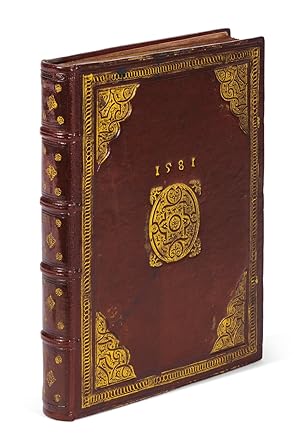
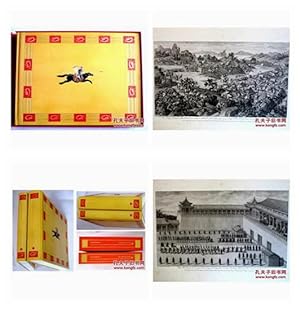

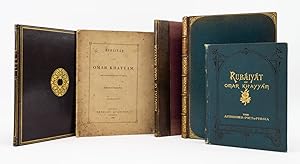
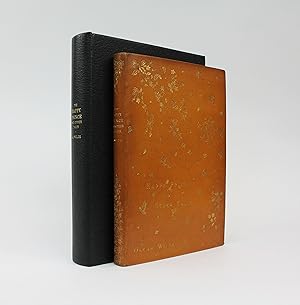
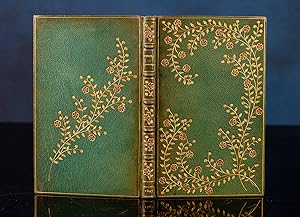
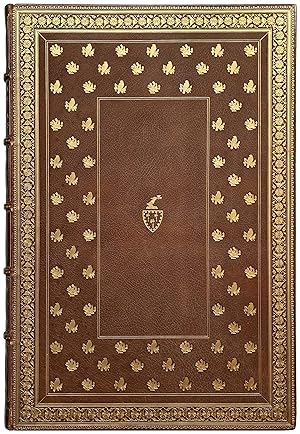

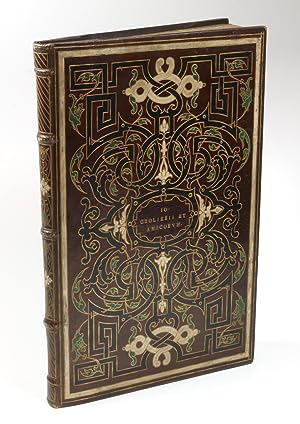
![Imagen del vendedor de Cosmographia [with:] De situ orbis a la venta por Donald A. Heald Rare Books (ABAA)](https://pictures.abebooks.com/inventory/md/md31814926085.jpg)
![Imagen del vendedor de [Polyglot] Biblia sacra polyglotta. Edidit Brianus Waltonus. a la venta por Heritage Book Shop, ABAA](https://pictures.abebooks.com/inventory/md/md31792025575.jpg)
